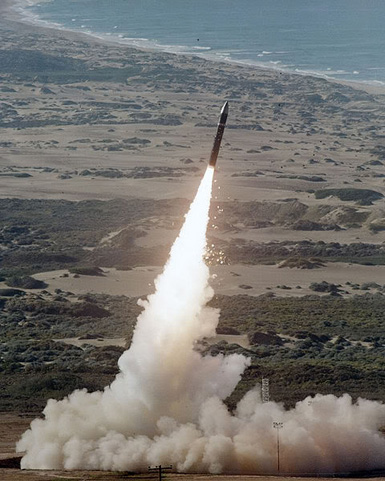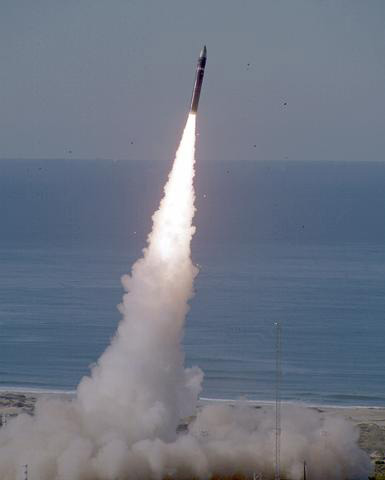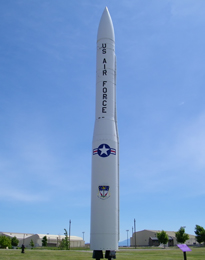
Peacekeeper Launch - Vandenberg AFB

Peacekeeper Launch - Vandenberg AFB
LGM-118A Peacekeeper Missile
The Peacekeeper missile, also known as Missile X, (Missile eXperimental) was one of the most radical of examples of a missile developed for the ICBM program. One of the primary motivating factors that led to the Peacekeeper missile being developed started back as early as 1971. Due to the continuing pressures of the Cold War, Strategic Air Command was significantly concerned that the Minuteman missile program was becoming obsolete.
Given the pattern previously developed with the Minuteman I, II, and III missiles, SAC was continuing to strive for an ICBM missile that possessed the ability of increased range, greater accuracy, and a greater payload consisting of warheads that possessed variable yield capability. During this time the Soviet Union was continuing to move forward in improving its ICBM force, and SAC was becoming increasingly anxious to develop a missile that had superior multiple silo killing capacity to counter what the Soviets had in their arsenal. Thus the necessity of the LGM-118A Peacekeeper missile.
The design and development of the Peacekeeper missile started to gain momentum on April 4, 1972, when Air Force Headquarters designated this new missile, Missile X, or MX, as the latest highly advanced ballistic missile. The Air Force looked to the Space and Missile Systems Organization (SAMSO) to take on the responsibility to design and build this new missile.
One of biggest obstacles facing this missile was the major concern of how the Air Force was going to base this missile. The argument mainly revolved around whether to base the missile in hardened missile silos, or to utilize a mobile basing force. The latter option would require that each Peacekeeper missile would be moved from one location to another, making it extremely difficult for the Soviet Union to target these missiles with their own silo killing missiles.
What added complexity to the basing quandary was that the Air Force was fully aware that the Soviet Unions' ICBM program was continuing to improve. Their ICBM missiles had increased range, higher yield warheads, and the capability of having MIRV warheads that possessed greater accuracy. One such missile was the Soviet's SS-18 missile that was housed in super hardened silos, making it an absolute necessity to utilize the Peacekeeper's greater accuracy and higher yield warheads, making it possible to take out the SS-18. The knowledge that the SS-18's primary purpose was to take out the Minuteman missile of the United States, added urgency to develop and deploy the Peacekeeper.
Adding to the complexity of basing the Peacekeeper was the realization that given the superior multiple silo killing capacity of this missile, the Soviets would not hesitate in the investment of using 10 of their missiles to take out one Peacekeeper Launch Facility. It took many years for Strategic Air Command, Congress and the defense department to come to a consensus on how they would base this missile.
In total, close to 40 different basing options were considered for the Peacekeeper missile. Launching the missile from a huge cargo jet was explored. "Deep basing" in hardened silos 1000 feet underground, as well as silos that were approximately 150 feet underground were discussed. The rail garrison was another topic of debate previously considered with the Minuteman I, was up for discussion. Shuttling the missiles on large trucks or rail cars to and from Multiple Protective Shelters was approved by the Jimmy Carter administration. Grouping the missile silos in a "dense pack", silos located close to one another, was yet another basing option that was explored.
Full scale development of the Peacekeeper missile began on September 7, 1979 along with the approval of the new basing plan called Multiple Protective Shelters, MPS. This plan consisted of 200 Peacekeeper missiles that would be shuttled back and forth between 4600 soft shelters located across the north eastern and south western quarters of Nevada and Utah. This plan caused a great deal of criticism politically, primarily due to the significant amount of land use and the high cost, which was estimated to be over $37 billion dollars, to implement.
With Ronald Reagan running for president, he stated that if he were elected, he would cancel the MPS system. Following his election Reagan replaced the MPS system with a deployment program consisting of two phases. The first phase involved placing the missiles in silos, with the second phase being developed at a later date with a more survivable basing system. Congress immediately rejected the plan to place the Peacekeeper in Minuteman launch facilities.
The Reagan administration went back to evaluating a basing mode and came back to Congress with the Dense Pack proposal on November 22, 1982. With this system, 100 Peacekeeper missiles would be emplaced in super hard silos spaced 1800 feet apart. The theory was that if targeted, since the silos were so close together, the explosions of the first wave of Soviet warheads would detonate the second wave of warheads, thus protecting the silos. This was a form of "Fraticide".
Once again, with the contentiousness of what this missile had been causing since its early stages of design starting back in 1972, Congress immediately rejected the Dense Pack basing mode. Congress also wanted to express its agitation with the Peacekeeper program by withholding funding for the procurement of the first missiles. It also put a halt to any further flight testing until a basing mode was approved.
Faced with a stalled program, in early January 1983 the Reagan administration formed a bipartisan committee tasked with deciding just how the Peacekeeper missile would be based. This committee was called the Scrowcroft Committee, and in April 1983 it issued its findings stating that the Peacekeeper should be quickly deployed in modified Minuteman launch facilities. Following this deployment would be the development and deployment of the small mobile ICBM, which became known as the SICBM, or the Midgetman missile.
President Reagan voiced his support for this report on April 19, 1983 and on May 26 Congress lent its support as well. Flight testing started and on June 18, 1983 the first Peacekeeper missile was launched from its shipping container.
As flight testing moved forward, $4.8 billion was allocated in September 1983 for the production of 21 Peacekeeper missiles. The design review of the support system for the missile was approved in October 1983. Construction of the support facilities began at F.E. Warren Air Force Base in mid 1984.
In developing plans to deploy the Peacekeeper, a number of changes had to be made to the Minuteman Launch Facilities at F.E. Warren AFB. First on the list was the Launch Facilities' guidance and cooling system had to be replaced with more powerful units. Next was the Launch Facilities power unit necessitated replacement with a new 96 volt DC power supply and an AC/DC converter, which led to replacing the emergency battery pack with new lead acid batteries.
In upgrading the control system, a UHF transmitter/receiver, as well as a demodulator/decoder were also installed to facilitate control by an Airborne Launch Control Center. Included in the changes was the installation of a new shock isolation system, and six feet of the silo launch control liner was removed to allow for the loading and unloading of the missile with the transporter/emplacer vehicle.
As the modifications on the Minuteman silos at FE Warren AFB continued, a major change in the Peacekeeper missile design came about. In 1982 the Department of Defense had decided to replace the Peacekeeper's original Mk-12A warheads with the new more accurate and less expensive Mk-21 warhead. Because this warhead is heavier than the Mk-12A, the maximum range of this missile was reduced.
This change in design also increased the weight of the Peacekeeper's payload beyond the SALT II treaties' limits. To offset this, fuel was removed from the fourth stage (the payload bus), which reduced the range of the missile even further. The final result was that the Peacekeeper would not have the range necessary to engage all possible Soviet targets from the launch sites in Southern Utah and Northern Nevada, as was initially planned with one of the earlier basing plans.
Testing Phase
The new Mk-21 Reentry Vehicle was first launched on a Peacekeeper in 1984, during the missile's fourth test launch. Following this launch saw the first Peacekeeper to be launched from a Minuteman silo on August 23, 1985. The first launch with 10 warheads occurred on June 21, 1986. The first test consisting of multiple targets happened that same summer, when two Peacekeeper RVs struck two separate targets 70 miles apart on August 23, 1986.
Peacekeeper Deployment
With the design and testing phase complete, the first four Peacekeeper missiles were delivered to Strategic Air Command in the fall of September, 1986. IOC, Initial Operational Capability was achieved at F.E. Warren AFB December 22, 1986. Initially, the Air Force experienced problems with the guidance units for the first Peacekeeper missiles, and January 1988 saw the Air Force making a total of 20 Peacekeeper missiles operational. The full deployment of 50 Peacekeeper missiles was completed by December 1988.
The signing of the START II treaty, which occurred on January 3, 1993, was the death knell for the Peacekeeper missile program. Due to the restrictions of MIRVed missiles outlined in START II, the Air Force started to withdraw the Peacekeeper missile from its ICBM force. The first 17 missiles were deactivated in 2003, and the new year of 2004 saw 29 Peacekeeper missiles still on operational alert. The following year, beginning at the start of 2005, the final 10 Peacekeepers remained on alert. The 400th Strategic Missile Squadron that oversaw the Peacekeeper missiles at FE Warren AFB, was deactivated on September 19, 2005.
An interesting aspect of the START II treaty being signed in 1993, witnessed the United States discontinuing its targeting of military and civilian areas in Russia, with its ICBMs. This occurred on May 30, 1994.

